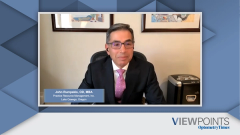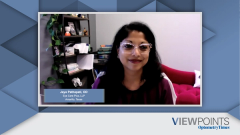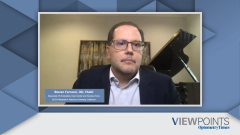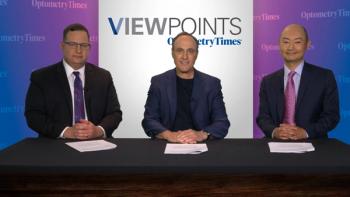
Routine Monitoring for AMD: Encouraging Patient Adherence
Strategies that can be applied in clinical practice to educate patients with dry age-related macular degeneration on the importance of routine monitoring to prevent disease progression.
Episodes in this series

John Rumpakis, OD, MBA: How about the frequency with the reliability of them showing up for chronic disease? Steve, you had said that sometimes you like to see them as frequently as every 3 months. I find that when I talk to individuals in practice, when I’m working with their practices, those patients with chronic disease states tend to leak a little. Three months turns into 4 months, and 4 months turns into 5 months. Now I’m seeing them twice a year instead of the 4 times a year I wanted to see them. Do you find that that’s something you’re dealing with, in your clinical situations and on a day-to-day basis?
Steven Ferrucci, OD, FAAO: That’s difficult, right? Because macular degeneration progresses so slowly, sometimes these patients don’t feel they’re having a huge problem. Obviously, if they felt they had a huge problem, they’d be more apt to come in for routine appointments. As Jaya was saying, it’s patient education. It’s talking to your patients, trying to explain to them why you want them to come in and what we’re trying to accomplish, and making them feel like they’re part of the process and contributing to their own health. It’s difficult in chronic conditions. Whether it’s macular degeneration, or glaucoma, or diabetes and diabetic retinopathy, it’s difficult if the patient doesn’t perceive they’re having an issue.
John Rumpakis, OD, MBA: In a dream world, the patient shows up when they’re supposed to and does exactly what they’re supposed to do, so you can have the ability to always diagnose the disease at the first clinical sign or quality-of-life adjustment sign that happens. Can you help me review the benefits of early diagnosis from preventing dry AMD [age-related macular degeneration] from progressing into wet AMD? Jaya, why don’t we start with you on that.
Jaya Pathapati, OD: The earlier a diagnosis, the better. Patients know this. We know this as doctors that monitoring a patient and early detection are key. Even though my techs do a phenomenal job of history and so forth, 1 thing we do before I start my clinical exam is get the family history of AMD, correct, and learn if they were previous smokers. I’m practicing in Texas, and I have a lot of ranchers who are previous smokers—heavy smokers who’ve quit and no longer consider themselves smokers. Previous history is important. “Yeah, 2 packs a day,”—slowly things come out, and then that risk factor goes up, and I’m going to be a lot more critical in monitoring and talking to them. OK, this is a risk factor. We’ve got to make sure we watch you more closely, and early detection means something is going on.
Some patients are very worried. What are you going to find? I don’t want to hear about it, Doc. And I say, do you want to find out when you’ve lost vision? We’re too late. We’ve missed the game already.
Education, education, early education. I’m thankful most of my patients with AMD are very good about their appointments because the initial visit when they come in, we spend a lot of time educating them on the benefits of close monitoring. The second thing is that we have our staff call anybody who misses, saying Dr Pathapati is worried that you didn’t show, because we want to make sure we preserve that vision. They have a little spiel to give patients so they understand that it’s very important to come in.
John Rumpakis, OD, MBA: How about with you, Steve?
Steven Ferrucci, OD, FAAO: Jaya makes some great points. When you think about diagnosis of AMD or early diagnosis, it’s a 2-pronged approach. We want to get those mild-dry patients, so we can talk to them about lifestyle changes, patient education, things they can do to prevent it from getting worse—no smoking, that sort of stuff. A recent study said that 50% of patients with macular degeneration claim that no one told them that they shouldn’t smoke, which I find hard to believe. Anyway, that’s the first category.
In the second category are patients who have dry disease, and we want to detect them as soon they convert from dry into wet disease. That’s important because multiple studies show us that smaller lesion size and smaller choroidal neovascular membranes do better with treatment. The sooner we can detect a patient has converted from dry to wet, the sooner we can get that patient treated over to the retinal specialist for appropriate treatment, the better off that patient is going to do in the long run.
There was recently a study, the 2020 IRIS [Intelligent Research in Sight] Registry, which looked at over 160,000 patients treated for neovascular AMD with anti-VEGF agents. What they found that was patients who entered treatment with 20/40 vision or better, maintained 20/40 vision or better at the end of 1 or 2 years. But no patient who entered treatment worse than 20/40 got better than 20/40. Vision is important to the outcomes. Unfortunately, some [patients] will convert from dry to wet. The sooner we can detect that conversion, the sooner we can get them treatment and, the studies tell us, the better off the patient will be.
Transcript edited for clarity.
Newsletter
Want more insights like this? Subscribe to Optometry Times and get clinical pearls and practice tips delivered straight to your inbox.













































.png)


